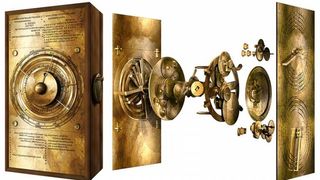New research into ripples in the fabric of space-time suggests that a nearly 2,000-year-old cosmic calculator followed the lunar calendar rather than the solar one.
The hand-operated “Antikythera mechanism” was recovered in pieces from a sunken shipwreck in the Aegean Sea in 1901, sparking more than a century of research into how this device was made and why. The box-shaped mechanical computer used gears and dials to track ancient astronomical events such as solar eclipses and the movements of planets.
Now, researchers are using cutting-edge work around gravitational waveswhich are waves in space-time caused by events such as black hole mergers or collisions between stars, to help discover the mechanics of ancient Greek gears from Antikythera. (The device is named after the Greek island near where it was found.)
“It has given me a new appreciation for the Antikythera Mechanism and the work and care that Greek craftsmen put into its manufacture – the precision of the position of the holes would have required very precise measuring techniques and an incredibly steady hand to drill them,” said study co-author Joseph Bayley, a research associate in the Department of Physics and Astronomy at the University of Glasgow. in a sentence.
Related: Famous Astronomers: How These Scientists Shaped Astronomy
The new study builds on earlier research from 2021 that used X-rays to show “new details of regularly spaced holes” beneath one of the mechanism's broken rings, according to the statement. Known as the “calendar ring,” this section is labeled with ancient Egyptian month names engraved in ancient Greek. according to the British Institute of Horology.
Computerized X-ray images “also revealed inscriptions describing the movements of the sun, moon and the five planets known in antiquity and how they were shown in the foreground like an ancient Greek cosmos,” reads the oldest study from 2021, published in Nature.
That 2021 study also noted the interdisciplinary nature of the Antikythera mechanism: “Solving this complex 3D puzzle reveals a genius creation: it combines cycles from Babylonian astronomy, mathematics from Plato's Academy, and ancient Greek astronomical theories.”
The new study, in Horological Magazinesuggests that researchers can predict how many holes there were in the calendar ring using statistical models that are derived, in part, from gravitational wave research. The study found that the calendar ring likely contained 354 holes, which follows a 354-day lunar year (or 12 cycles of the waxing and waning moon). Unlike the 365-day solar year that most of the world uses today, the Ancient Egyptian calendar followed the lunar year, as does the Islamic calendar that is still widely used around the world.
The team also drew inspiration from the channel of YouTuber and machinist Chris Budiselic, Click springBudiselic has been building a replica of the Antikythera mechanism while conducting independent research. Budiselic's team suggested the ring could contain between 347 and 367 holes.
One form of analysis, led by Glasgow astrophysics professor Graham Woan, came from Bayesian statistics. This “uses probability to quantify uncertainty based on incomplete data,” according to the statement.
The other part, of the gravitational wave research led by Bayley, was adapted from statistics used with data from LIGO (Laser Interferometer Gravitational Wave Observatory) which searches for waves in space-time. (Woan is also a LIGO researcher.)
Both statistical studies independently suggested the ring has either 354 or 355 holes. Previous studies had suggested the lunar calendar was more important to the Antikythera Mechanism's creators, but the new study “greatly increases the likelihood that this was the case,” Bayley said in the statement.
“It's a neat symmetry,” Woan added, “that we've adapted the techniques we use today to study the universe to understand more about a mechanism that helped people keep track of the heavens nearly two millennia ago.”
